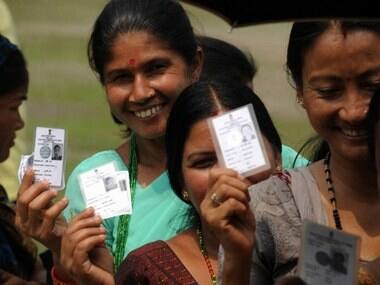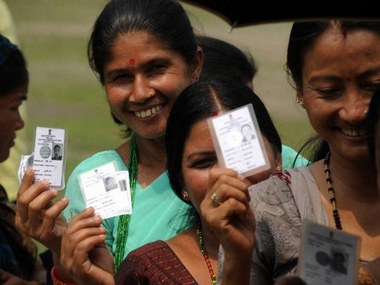This election, Bangalore’s swish set had everything going for it. The city’s darling Nandan Nilekani was in the fray on a Congress ticket. Infosys star V Balakrishnan was also contesting as an Aam Aadmi Party candidate, going as far as to claim that fighting polls was way more exciting than his Infosys job had ever been. [caption id=“attachment_1485189” align=“alignleft” width=“380”]  Representational image. AFP[/caption] That gushing support for the political process was backed by Bangalore citizens’ activism seeking better administration and transparent governance, for example through the Bangalore Political Action Committee, now at its peak. IT bigwigs, already prominent on the political landscape through their involvement in the city’s activism, were vocal about their expectations from Nilekani and Balakrishnan – these leaders could leverage IT for better service delivery. From NASSCOM to individual Bangalore-based technology companies, the support for these two candidates in particular, and for the Aam Aadmi Party in general, was heady. It really looked like that a problem solving approach, so unique to IT-defined Bangalore, was at hand to rescue democracy in the metro from too many elections marked by voter apathy and dismal turnouts. The Bangalore professional, it appeared, would lead the city’s decisive shift in voter behaviour, as people voted, en masse for change. Then came election day, and Bangalore recorded a dismal 54 percent voter turnout. In comparison, parts of Manipur saw an impressive 74 percent turnout, which was still less than its 2009 percentage of 77. Three constituencies in Chhattisgarh measured 63.44 percent, up from 57.60 in 2009. More tellingly, the rest of Karnataka also recorded a good turnout of 68 percent, 10 percent higher than 2009’s 58.88 percent. An op-ed page piece in The Indian Express reports that the signs had been starkly different in the days preceding polling day. “… the urban educated were visibly involved,” the report says. In Nilekani’s Bangalore South constituency, a volunteer campaign “driven entirely by urban professionals” had given veteran BJP leader Ananth Kumar’s well-practised campaign moves a run for its money. In Balakrishnan’s Bangalore Central constituency, the urban middle and upper middle classes were rooting for their Aam Aadmi Party candidate. There were flash mobs, door-to-door campaigns, street shows among busy shoppers on Brigade Road, human chains, fundraising dinners, with the urban and professional class of the city giving “every indication that the 2014 election was an election they fully owned”. So what happened to namma bengaluru coming voting day? The explanations for the poor turnout range from the obvious to the intellectual. Some claimed that Infosysians failed to convince sell voters a corporate approach to governance, including do-it-yourself solutions such as mini power plants, private security guards, private water supply systems. In a blog-post on the NDTV website, Air Deccan founder and Aam Aadmi Party member Capt GR Gopinath was more scathing. The software professionals of Bangalore had escaped to Chikmagalore and Coorg “for a long weekend," he wrote_, “where whiskey in hand, they could bemoan our corruption, our awful infrastructure and abuse our venal politicians and wax eloquent about a glittering Dubai and an impressive Singapore or an idyllic Switzerland_.” The Indian Express report said this class perhaps “prefers the cocoon of its gated enclaves and walled high-rises to engaging with the problems and solutions of the real India outside the gate”. Chances are that the real explanation lies somewhere in between. The urban, highly educated, upper middle-class, extraordinarily erudite Bangalore resident may be more of a talker than a doer, but we really can’t hold the turnout numbers against him or her. The Mint analysis compares last week’s turnout to the turnout in Karnataka’s last Assembly elections to find that the turnout higher this past week only in 10 out of the state’s 224 Assembly segments. “We find that on an average, the turnout in the parliamentary elections is about 7.5 percentage points lower than in the assembly elections,” the report says. More than the four-day weekend, perhaps Karnataka’s voters merely failed to shake off their historical apathy toward Parliamentary elections, where turnout is routinely lower than it is for state elections. In fact, Bangalore is one of the 12 Assembly segments that saw a higher voter turnout this time than in the Assembly election last year. “…seven out of the 10 constituencies that have seen an increase in voting percentage compared with the 2013 Assembly elections are in urban areas,” the report says. Having said that, holding a polling day at either end of a long weekend is never going to be a good idea, no matter how much fresh blood is in the fray and how much enthusiasm in the campaign period. Politicians can fret and seek solutions ( Advani has asked for voters who skip an election to be debarred next election), but it takes more than a critical national election to alter resolute vacationers’ plans. The brouhaha over the voter turnout is but to be expected given all the media coverage devoted to the urban middle class “revolution” since the heady days of the Lokpal. the rest of urban India will be watched closely as elections progress. Mumbai, another city famous for holidaying on polling day, will face its litmus test this Thursday. If Mumbai fails to pass muster, we’ll know that Delhi’s record 65.09 percent turnout in the Lok Sabha election was a flash in the pan. And that’s certainly bad news for AAP and others trying to shake urban India out of a rut of deja vu.
So, Bangalore did a no-show once again, inviting general ire for its apathy to elections and its 54 percent turnout. But the IT professional-turned-political activist may not be solely to blame.
Advertisement
End of Article


)
)
)
)
)
)
)
)
)



